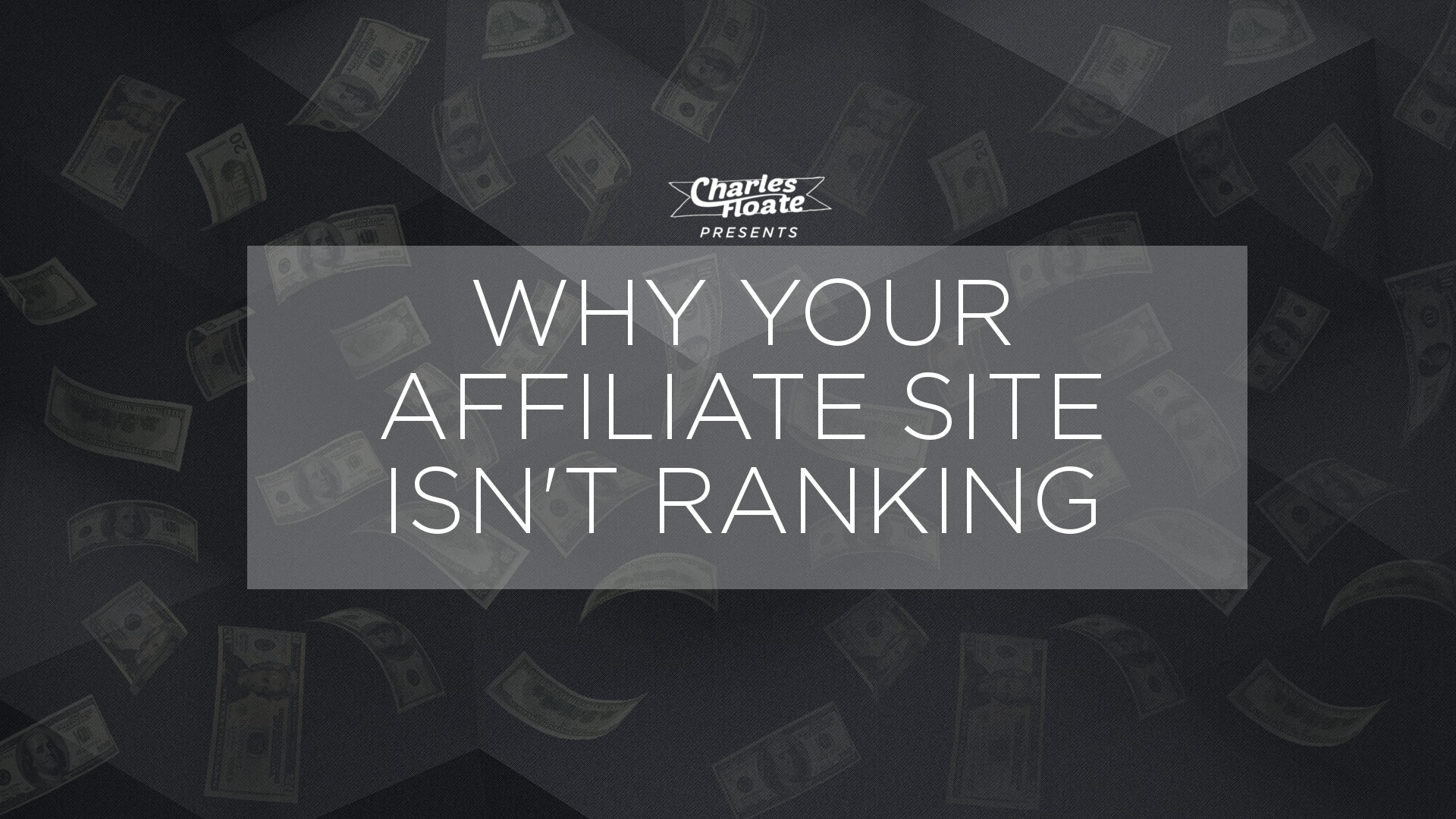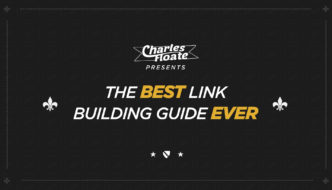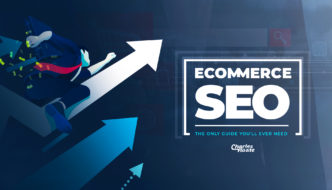Trigger Warning: I know, I may sound like a bit of a douche in this post with some of the bashing I am doing on perhaps newbie SEOs, but some of the people I’ve talked to that have these issues have been doing this stuff for years.. God help us if this is what the result of years of learning is.
In my time as an SEO, I’ve provided over 300 hours of consulting. The majority of those hours is spent working with affiliate SEOs, as they tend to be my #1 reader base. The most common occurrence I see happening is that people’s sites are getting trickles of traffic (maybe 200, to 2,000 organics visits a month) but they get stuck.. Everything they buy, everything they “try”, everything they “do” just doesn’t seem to work.
I put the latter 2 parts in quotation marks because realistically, all they’re doing is throwing more wood onto a fire that is in the wrong part of the house.
The majority of problems I see with SEOs, is that they invest hundreds, if not thousands of dollars into link building but completely neglect the site itself.. They don’t put enough emphasis on the OnPage, they design the entire site poorly so it doesn’t convert and when it gets to those top #3 positions people bounce off like a god damn trampoline and they go falling back down the ranks. Of course, they have a significant problems with the types of links they’re building as well, but we’ll cover that in detail at the end.. As the majority of sites I see, are piss poor excuses for affiliate sites.
Table of Contents
Stop “Designing Your Sites AFTER They Rank”
Seriously, this is one of my pet hates in SEO.. and whoever told you to do it, is an {idiot|mornon|fool}.
As soon as that site hits anywhere in Google and starts getting any amount of traffic, you want your bounce rate to be solid. Having a default theme, no logo yet and poor overall conversion rate optimization/design/branding is just going to lead you down a slippery slope of making it even harder to rank in Google.
This is because Google test new sites with drips of traffic and see how they perform.. This is why you’ll see your site dancing all over the place at the start, Google is testing you, seeing if you’re worthy of higher rankings and more traffic. If your site isn’t ready for even that initial traffic, you’ll be sandboxed (it’s just a term, don’t take it too seriously) for it and find it a lot more difficult to play their game again.
Rekindle The Basics
Whenever I see money pages with auto-generated meta titles and descriptions, it really grinds my gears.
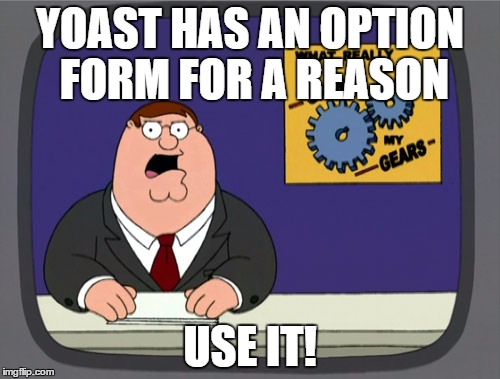
Allowing Yoast to input auto-generated meta data isn’t the only basic BS I see from these sites. No sitemaps, no alt tags, bolding the same keyword 15 times, lack of breadcrumbs and so on.. It’s an uphill battle to rank a page when your meta title is 70 characters too long. This is why I aptly named my OnPage post “the lost art”, because it seems people can invest $2,000 into PBN links but lack the basic skill set to configure plugins in a WordPress installation.
A Quick OnPage (Meta Data) Tutorial
For those that’ll inevitably complain about me not giving any actual info in this section.. Here we go:
Step 1) Download & Run Screaming Frog
For $0, yes $0! You can run a site with up to 500 pages.. That’s more than most affiliate sites I’ve ever come across (which is sad really) and I doubt will be more than the amount you have on your site. Download here, it’s an SEO Spider for those that don’t know, aka it’ll crawl your site and export a bunch of data, including my much coveted meta data.
Step 2) Export To Excel & Start Editing
Once you’ve got your site in Excel in front of you, begin by going through every page title that has a pipeline (that’s | < for anyone wondering) and re-writing the auto-generated garbage that your SEO plugin of choice has spat out for you.
Do the same with your meta descriptions, often you’ll find they have none because you didn’t enter one.
Step 3) Go Live
Now that you have custom meta data for every page on your site, open the links from Excel and copy/paste the data into the little box you have on every page/post editor:
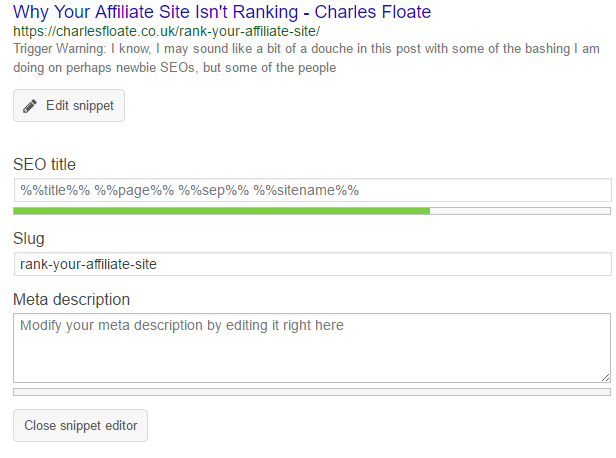
Great, now you’ve improved your chances of ranking ten fold.. because you now have keyword optimized meta data.
Note: I know this sounds stupid, but you wouldn’t believe the amount of sites I’ve seen that would generate a ton more traffic following this tutorial.
Grow Your Sites, Stop Letting The Dust Settle
Like I said above in regards to the 500 pages you can get with Screaming Frog.. Most affiliate sites I see out there are 5 – 30 pages big, and they were built at one point in time, with no new/fresh content added ever since.
I’m not sure if it’s fear or stupidity playing the role in why people leave sites.. but just adding links alone won’t get you the rankings you want, and you’ll likely be missing out on a TON of traffic if you aren’t consistently expanding your sites.
Does it strike fear into your hearts when I say my average affiliate site is over 300 pages big? 300 pages of actual content too, because I noindex my non-unique pages (e.g. category, archive, author etc pages) – It shouldn’t, because growing your site to that many is actually really easy.
Low Hanging Fruit Keywords/Pages
Once my site is doing ok and has been doing for several weeks or even months, I stick the page through Ahrefs (or SEMRush, though they recently have been showing a lot less data than Ahrefs), not for the links, but for there positions explorer.
You’ll need to export the data from SEMRush to do this, but in Ahrefs I run the page through and then go to my filters in positions explorer, and filter the positions to #8 – #30 –
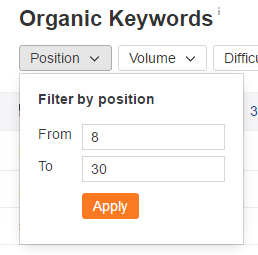
This shows me any keywords I am ranking for in positions #8 to #30.
As an example, I’ll use this blog (not a page, but the entire blog) –
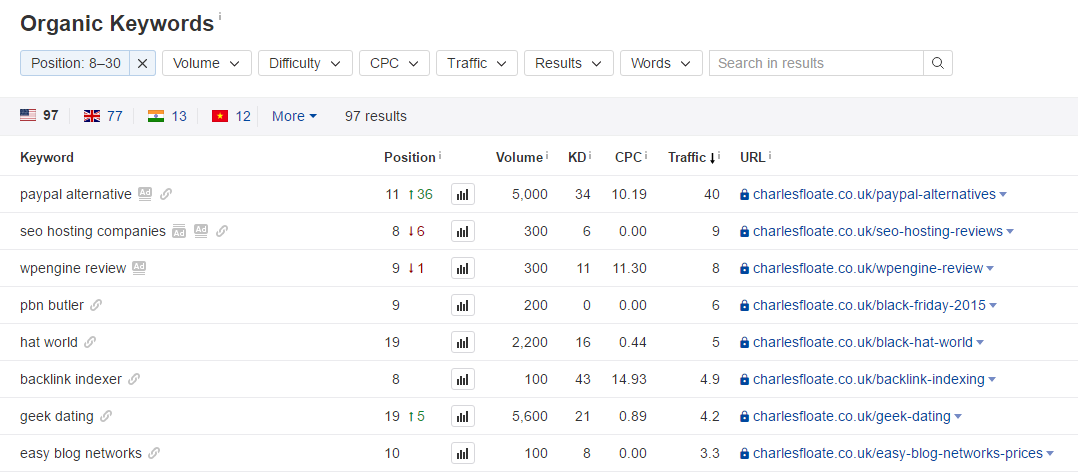
You’ll note several money keywords here that I could either create a new page for (if the current one ranking isn’t relevant enough) or update the current page to have a higher density, or fire some more links at it.
As an example:
- wpengine review – I could add 1 or 2 exact match links to this and get it boosted for a 300 MS keyword, possibly results in several hundred dollars in affiliate commissions.
- easy blog networks – I could update the current page (as it has quite a low amount of overall content) to get more traffic to it, and make more affiliate commissions.
- backlink indexing – Though I have a page on indexing, I could make a page specifically on indexers which would outrank the current page and get more traffic/commissions.
And so on..
You’ll quickly find repeating this practice once or twice a week will start slowly adding more and more traffic without having to spend a huge amount of money or time. As long as your niche is broad enough, you should continually find new keywords.
Save Money With Topical SEO
People will invest hundreds of dollars into filler content for their blog networks, but won’t do the same for the actual money site? And no, the 3 posts you put up when you created the site to “bulk out the site” don’t count.
For every money page on your site, I highly suggest having a number of interlinked topically related pages to back it up –
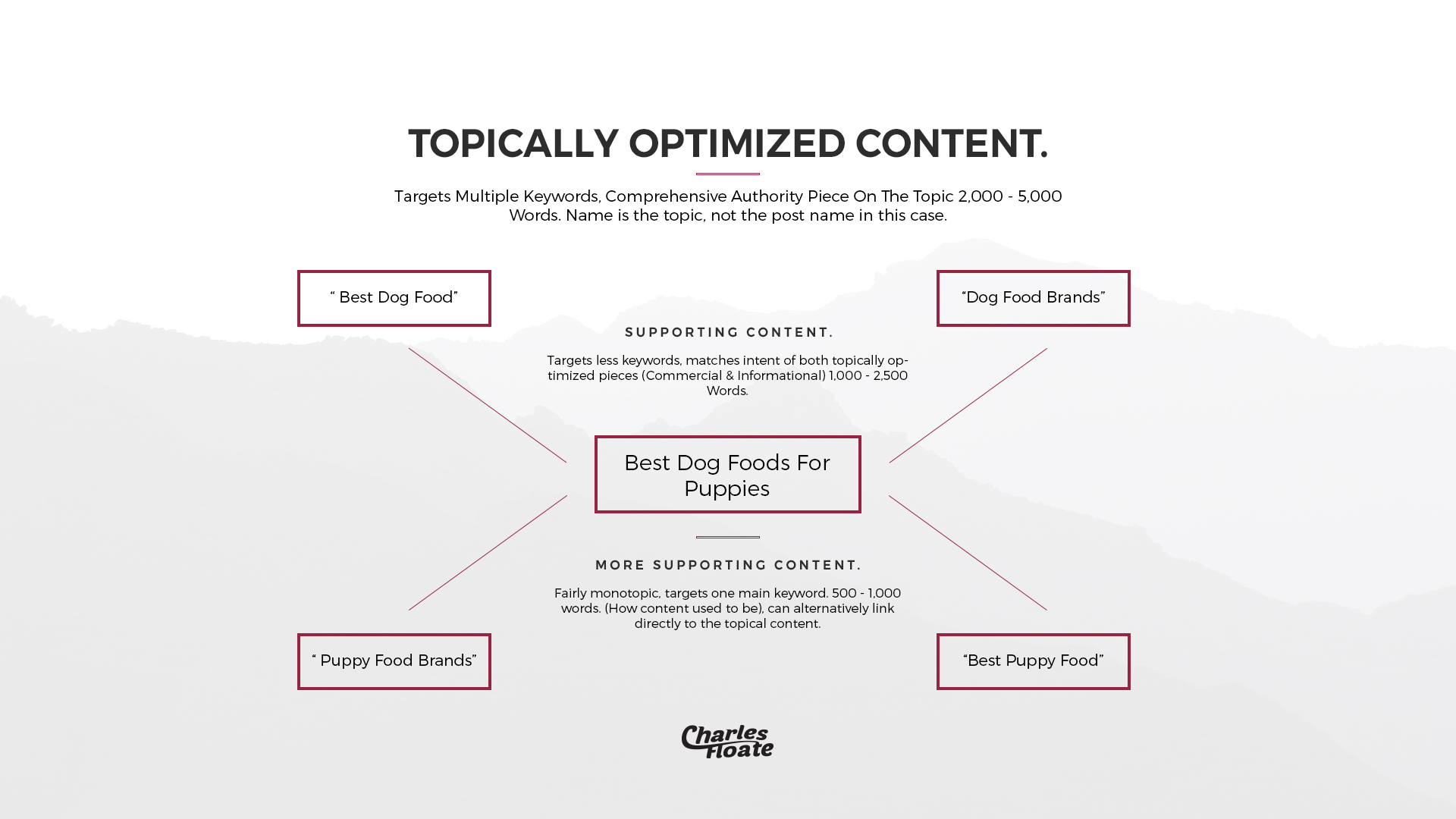
Think how much cheaper it is to buy one article than buy a PBN link, think of how little time it takes to write an article than setup an entire PBN and link out from it to your money page.
If you repeat this process for every money page on your site, as an example, let’s say you have 10.. That’s 40 new pages on your site, interlinked, with large amounts of unique content.. That creates something no PBN links will ever create for your site: Real, gained authority.
By “real, gained authority” I simply mean that Google recognizes you’re a site dedicated to this niche/industry and gives you credibility and authority for it.
I wrote a guide to topical SEO here, so I won’t spend any more of time going on about it.
Take Pride In Your Design
You don’t have to be Picasso or Zuckerberg to create a good looking website, now-a-days a premium theme from ThemeForest and the Thrive Content Builder plugin allows you to create some gorgeous money pages/sites – And no, I’m not recommending a theme to you, I suggest using one with a solid load time and that looks like it’d be a site in your niche.
Time and time again I see poorly made logos, orange buttons on red backgrounds, navigation bars that are filled with post names and font choices that look like the horrific fonts an English teacher would choose for her presentation on “of men and mice” – It’s not hard to see if a page looks good, and if you need some real inspiration then look at this blog.. I get compliments for how well it flows all the time, and it took my developer a couple of hours of hacking a default theme from StudioPress.
This section follows me nicely onto my next point:
CRO Is Just As Important As Ranking
One of the things even I could vastly improve on is my knowledge of conversion rate optimization. I’m not going to go into detail here and pretend to be an expert on a subject that I’m not, but Kurt (on Matt Diggity’s blog) did a fantastic post on CRO for SEOs here.
CRO can not only improve your sales but can actually vastly improve your SEO, because it’ll ideally way lower your bounce rate which has been proven to have a significant effect on your rankings. The main reason for it though, is because it can also juice a TON more cash out of an affiliate site.
If you’re doing 1,000 visits a month, and converting at 2%, that’s 20 commissions a month. With some split testing, different page layouts, adding SSL to increase the buyers trust and so on.. You could potentially increase that rate to 5% (which is a very realistic number), which would mean a 150% increase in the profitability of your site.. That’s a lot more than any short term SEO campaign would likely ever bring.
Your Link Building Is Dreadful
You think 50 PBN links in 3 weeks and some blog comments to a domain that is a month old looks natural? You think spending 30 hours building a super complex IFTTT link wheel is going to help you rank for a 40,000 MS keyword?
No.. And link building is actually the easy part.
Once you have a well prepared site, with solid OnPage, enough pages, good CRO, then it shouldn’t be that difficult to start competing in even some of the more competitive niches with a good link building campaign.
Now, the biggest reason I see people fail to understand what a “good link building campaign” is, is because of the terminology used. If you’re new or even beginner level to SEO, the terminology used can be extremely difficult to wrap your head around. You’ll see PBNs, 2.0s and submissions flying around everywhere.. And it’s hard to get down a solid strategy that’ll work.
A Basic Affiliate Link Building Strategy
I thought I’d give some of you a bit of a helping hand and show you a step-by-step strategy, rather than just showing you various techniques.
Note: This strategy is an EXAMPLE, please do not come back commenting in 3 months time telling me it didn’t work. Every niche is different, every competition is different and you need to do your own due diligence before carrying out any campaign.
Note #2: I’d also like to add that I’m not going to be going into detail about how to do some of these link building techniques, I’ve linked to my guide at the bottom of this post for you to check out anyway, which’ll cover the majority of these techniques in detail.
Week 1/2 – Authority Building
You can do these type of links before you’ve got a fully functional site up, just make sure you have at least a homepage ready for any potential comment moderators.
Build Your Social Profiles Out
Easy enough: Brand up and get those social profiles (Facebook, Twitter, YouTube, Pinterest, Google+ etc.. Whatever matches your industry/niche) built up and linked back to your money site.
Do 1 – 3 REAL Blog Comments A Day
Find some genuinely good blog posts using the WordPress commenting system, read the post (you might actually learn something about the niche you’re going into) and do an apt response – Make sure to note down your comments so you can check back later to see if they’re approved, and potentially use those blogs that you’ve built your comment on as guest posting opportunities.. Tends to help securing a guest post if someone actually see’s that you’re part of their community.
Make A Decent Piece of Content & Get It Some Traffic
Find a hap in the market for a piece of content that you can spend a few hours writing.. Then link build all over the shop.
Join forums and say you’re a new blogger in the sphere wanting feedback, post it to a relevant subreddit and get a dofollow link from a text post, find questions on Quora & Yahoo answers that can be answered by a quote from your post.
This is real link building, and will actually increase your knowledge in the niche because you’ll likely get feedback, and the links are an added bonus.
Week 3 Through 8 – Boost That Juice
This is where you’ll start seeing your links really start to have an effect.
PBNs, Guest Posts or Both (Tier 1)
Whether you decide to invest a ton of time into doing a full scale outreach campaign, or you drop $500 on some HQ PBN links from Diggity.. These are the links that you can use your exact and partial match anchors on to start having a serious affect on your money pages.
Infographic Submissions (Tier 1)
It takes $5 to get a decent infographic made on Fiverr, then all it takes is a few hours to submit it to every infographic directory you can get your hands on.
SAPE (Tier 2)
Though I don’t suggest building SAPE links to a PBN that isn’t yours, you can be a bit brutal with guest posts as the kind bloggers that gave you them likely don’t have a Ahrefs or Majestic subscription.
Buying 1 – 3 HQ ($1 – $5/mo) English-only links with URL/branded anchors per tier 1.
Link Indexing
PBNs and guest posts can be left to index on there own, but infographic submissions, social profiles and comments often need a bit of help to get indexed within a reasonable amount of time.
Here’s a few options:
- Badass Indexer – Holly Stark’s $300 automated Google Submit URL tool, does require captcha solving.
- Link Pipeline – Premium monthly subscription, much cheaper than Badass but much slower too.
- Google’s Submit URL Tool – Requires a Google account to use, but generally indexes links pretty quickly once done. Be careful with BH sites from the same Google account.
Week 9 And Onwards – Keep Creating Authority
You’ve spent 8 weeks building a foundation for your link profile that’ll hopefully of ranked you or gotten you on your way to ranking. Now it’s time to carry on building out and expanding your link profile using various techniques.
Some Additional Link Building Thoughts
I just wanted to add in 2 extra thoughts I have had from interactions with various people about link building –
Anchor Ratios Does Not Mean Literally 20%
This was a recent question I actually recieved from someone who recently joined my affiliate course.
If I say “The best anchor text ratio is 10%” – That does not mean, out of 100 links, 10 of them should have keyword A, 10 of them should have keyword B and so on… It means, that out of a total of 100 links, 10 of them should have your keywords in it, the other 90 can be a mixture of mostly branded/generic/names, and some longtails to boot.
Note: 10% is not an exact recommendation, but it’s probably a good starting block and a fair anchor ratio.
Stop Using Tactics From 2011
Some of these are up for debate by certain people, and yes, some people will of had success with them.. but as a rule of thumb for modern day link building, these link types are not good:
- social bookmarks
- article directories
- spam directories
- RSS submitters
- pingbacks/indexers (ok in small amounts for indexing)
- guestbooks
- URL shortner/301 spam
As well as various hyped up link building “types” like “paul and angela backlinks” – Yes, seriously, I still get emails about these links…
Overall, if you’re wanting a safe link building guide, follow mine.
Thanks For Reading
I hope you enjoyed this post and it gave you a kick up the arse (so to speak) to make those much needed changes to your sites.
If you’d like to get more knowledge bombs on SEO, join my free 7 day SEO email course down below, and whilst you’re at it, why not drop a comment with your thoughts on affiliate SEO/bad affiliate SEO.

